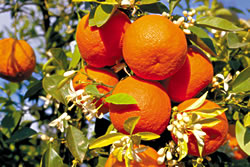BUSINESS
Inside SCV History
A Continuation of the Santa Clarita Valley Story
April, 2006 - Issue #18
 |
It was along this route that the town of Newhall was born. By 1879, the town blossomed. Two city blocks were deeded to Newhall, who oversaw the construction of an extravagant hotel and beautiful city plaza. That same year, the California Star Oil Company, whose wells near what would become Mentryville, started pumping. The state's first oil refinery was built outside the town along the railroad tracks in Newhall. In addition to the Southern Hotel (which was considered the most luxurious in the state outside of San Francisco), a one-room school house, general store, several saloons and a lumberyard made up the rest of the town. (Both the hotel and the school house burned down within the decade. Santa Clarita, supporting education even from its earliest days, forewent rebuilding the grand hotel and instead rebuilt an adobe school house, which now stands at the Historic Junction in Hart Park.)
Soon, acres upon acres of laborers' tents sprung up as farming got under way. In 1879, 5,000 acres of planted lands produced over 12 million pounds of wheat. In addition, Newhall tried his hand at growing non-native plants from the tropic including sugar, flax and citrus crops along with a standard orchard assortment totaling 1,500 acres. All were successful except the oranges, which froze in the colder Newhall winter, compared with the slightly more temperate climate of Heritage Valley and the route to the sea.
The Newhall family continued to grow as the five sons started families of their own. Two pursued an education at Yale, while the others went straight into the family land business. It would only be a short time before the passing of Henry Mayo Newhall, in March 1882, left the future of the company in the hands of his wife and sons. During his lifetime, Henry had amassed a personal fortune of over $2.5 million. Adjusted conservatively for inflation, and not counting the exponential increase in land cost (he owned over 140,000 acres), his fortune would exceed $20 million dollars today.
--------------------------------------------------------------
Much of the research from this article came from "A California Legend: The Newhall Land and Farming Company" by Ruth Waldo Newhall. The book is highly recommend to everyone living, working or interested in the Santa Clarita Valley.
|
||||||||||||||||||||||||||||




